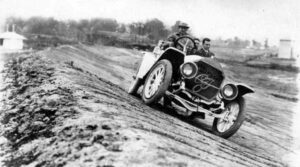Garrett Steenblik’s story as a truck driver isn’t a typical one — but it is certainly inspirational.
Just a few years into his driving career, Steenblik says he realized the sedentary lifestyle and poor eating habits he developed on the road had placed him in a life-threatening health crisis.
“I was trapped in a cycle of daily nausea, excruciating pain and sleepless nights, burdened with diagnoses of fatty liver disease and ulcers,” he told The Trucker. “On top of that, I battled crippling anxiety, depression and PTSD from a childhood consumed by abuse.”
To cope, Steenblik started a regimen.
Unfortunately, it was not a regimen that would lead to a positive outcome. He developed a habit of chugging three Mountain Dews a day and binge eating, desperately trying to escape the pain that consumed him.
It didn’t take long for these destructive habits to take a toll on his overall health.
A journey faced by many
Steenblik isn’t the first driver to face health- and diet-related challenges on the job — and he certainly won’t be the last. By its very nature, over-the-road trucking presents unique barriers to balanced nutrition and regular physical activity.
“While our society depends on the vital work of the trucking industry, truck drivers have scant support in maintaining their well-being,” he said. “This is a public health crisis.”
Steenblik is matter of fact when he discusses the role motor carriers — at least those he observes — play in the lives of employees.
“We’re expected to work 10-14 hours a day — over 70 hours a week,” he said, noting that this schedule leaves little to no time for meal planning and exercise.
According to Steenblik, many truckers subsist on cheap, readily accessible meal options, such as fast food and gas station snacks — and he should know.
He was one of them.
Luckily, Steenblik reached a breaking point, one where he recognized he was caught in a personal health crisis.
Unfortunately, many drivers never have that realization.
“I decided to change while I was hunched over a toilet bowl, feeling defeated. I realized I was a victim of my own choices, and I refused to remain a hostage to my past” he said.
“In that moment of desperation, I found a flicker of determination” he continued. “I channeled the same discipline I used to navigate the open roads into a fierce commitment to my own health.”
Challenges along the journey
Steenblik knew the road ahead would be hard, and he knew he didn’t have all the answers — but that feeling was not foreign to him. After all, he’d faced the unknown when he entered the trucking industry after leaving a sedentary, dead-end tech job and watching his weight grow to 360 pounds.
Among the first challenges ahead was the financial cost of making personal health changes.
As with many truckers’ health care plans, he says, his insurance plan’s coverage of preventative health care and weight loss treatment was inadequate — and his health had deteriorated to the point that the out-of-pocket expenses for healthcare associated with his wellness journey would be in the tens of thousands of dollars.
On top of that, the monetary cost was actually one of the least of his challenges: Changing his lifestyle would take perseverance and strength from within like nothing he’d ever undertaken in his 24 years.
“My demanding driving schedule necessitates long hours seated behind the wheel,” he explained. “The lifestyle impedes regular physical activity and encourages reliance on cheap, calorically dense convenience foods.”
Steenblik knew he needed a strategy. The first order of business, he says, was to work on his diet and adopt an exercise regimen.
“I lost my first 100 pounds simply by running in place for 45 minutes a day over 11 months,” he said. However, as he discovered, “I couldn’t outrun a poor diet.”
Despite a rigorous exercise routine, his weight climbed as he continued to binge eat.
“My breakthrough came when I learned about total daily energy expenditure and basal metabolic rate,” he said. “I began to understand how many calories my body burned daily and how to eat in a calorie deficit for weight loss.”
Steenblik adopted a low-carb, whole-food diet, practiced intermittent fasting — and swapped hamburgers and fries for vegetables and lean protein.
“As I improved my diet and exercise, my depression, anxiety and trauma began to lose their grip on my life,” he said. “I realized that mental health starts with physical health, and I found I could reshape my identity and heal.”
A partner on the journey
During his journey to better health, Steenblik says he received a lot of support from his wife — who also happens to have been Steenblik’s team driving partner for eight years.
“My wife, Yvonne, is a powerful source of accountability and support. She’s played an essential role in my health journey through her love and encouragement,” he said, adding that his wife, who is certified in hazmat and tanker operations, is an active team driver.
“We drive as a team, balancing the demands of our job with maintaining our health,” he said.
However, he says, his wife faces additional challenges to maintaining her health on the road.
“It’s not always safe for her to exercise outside alone, especially as a night driver,” he said. “Team driving is intense and requires immense coordination and trust. While one of us drives, the other rests, making it challenging to find time for exercise.”
But together, they made the journey.
“We both made it a priority to work out during breaks or while waiting to load — doing body-weight exercises regardless of conditions,” he said.
It was a slow process — in fact, his journey spanned five years — but Steenblik eventually reached his health goals. And those goals were ones that anyone, regardless of their profession, should be proud to achieve.
“I ultimately reached 155 pounds, primarily through keto (diet) and intermittent fasting,” he said. “It took years to lose 200 pounds through diet and exercise.”
The massive weight loss left him with an extraordinary amount of sagging skin that could only be removed through surgery. This required time and money, not only for the operation, but also to recuperate.
“I used weight-loss medication to manage the weight fluctuations during recovery, going up to 185 pounds and then back down to my normal weight of around 160,” Steenblik said.
A continuing journey
While his personal mission has been achieved, Steenblik says he continues to face daily challenges in order to maintain his weight and health.
He wants to use his journey to inspire other drivers to take charge of their health.
“My personal experience of fighting to get my health back while fulfilling my job requirements brought me face to face with the enormous obstacles that truckers face in maintaining a healthy lifestyle,” he said.
“My story of returning to wellbeing while driving is exceptional, but it shouldn’t be,” he continued. “My mission is to bring attention to the unique obstacles drivers face when it comes to accessing health care and implementing lifestyle changes.”
Steenblik hopes his story raises awareness about rampant health issues in the trucking industry.
“I offer myself as a resource for fellow truckers looking to improve their overall well-being,” he said. “I connect and offer free health consulting in trucking groups on Facebook, reaching truckers on forums they can easily access.”
Steenblik uses his personal story as a call to action for other drivers — and people in general — who are unhealthy.
“I encourage readers to evaluate their own health needs and support wellness initiatives within the industry,” he said. “Draw inspiration from one another and join the movement toward better health in trucking.”
Since retiring from a career as an outdoor recreation professional from the State of Arkansas, Kris Rutherford has worked as a freelance writer and, with his wife, owns and publishes a small Northeast Texas newspaper, The Roxton Progress. Kris has worked as a ghostwriter and editor and has authored seven books of his own. He became interested in the trucking industry as a child in the 1970s when his family traveled the interstates twice a year between their home in Maine and their native Texas. He has been a classic country music enthusiast since the age of nine when he developed a special interest in trucking songs.








